Boshin War
The Boshin War (戊辰戦争, Boshin Sensō, lit. "War of the Year of the Yang Earth Dragon"), sometimes known as the Japanese Revolution, was a civil war in Japan, fought from 1868 to 1869 between forces of the ruling Tokugawa shogunate and those seeking to return political power to the Imperial Court.
| Boshin War 戊辰戦争 (1868–1869) | |||||||
|---|---|---|---|---|---|---|---|
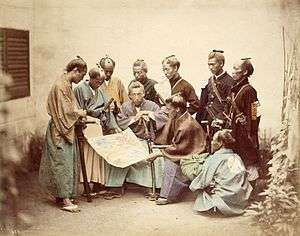 Photograph of samurai of the Satsuma Domain by Felice Beato | |||||||
| |||||||
| Belligerents | |||||||
| 1868 |
1868
Defected: | ||||||
|
1869 Supported by: |
1869 Supported by: | ||||||
| Commanders and leaders | |||||||
1868–1869
|
1868 1869
| ||||||
| Strength | |||||||
| more than 15.000 (early 1868)[3] | |||||||
| Casualties and losses | |||||||
| 1.125+ killed and wounded | 4.550+ killed, wounded and captured | ||||||
|
Total: 8.200 killed and 5.000+ wounded[4] | |||||||
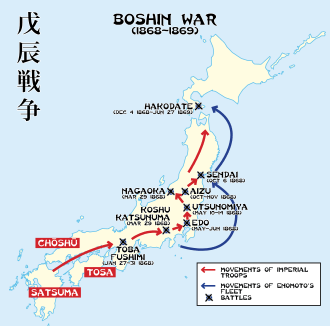
The war was founded in dissatisfaction among many nobles and young samurai with the shogunate's handling of foreigners following the opening of Japan during the prior decade. Increasing Western influence in the economy led to a decline similar to that of other Asian countries at the time. An alliance of western samurai, particularly the domains of Chōshū, Satsuma and Tosa, and court officials secured control of the Imperial Court and influenced the young Emperor Meiji. Tokugawa Yoshinobu, the sitting shōgun, realizing the futility of his situation, abdicated political power to the emperor. Yoshinobu had hoped that by doing this, the House of Tokugawa could be preserved and participate in the future government.
However, military movements by imperial forces, partisan violence in Edo, and an imperial decree promoted by Satsuma and Chōshū abolishing the House of Tokugawa led Yoshinobu to launch a military campaign to seize the emperor's court in Kyoto. The military tide rapidly turned in favour of the smaller but relatively modernized imperial faction, and, after a series of battles culminating in the surrender of Edo, Yoshinobu personally surrendered. Those loyal to the Tokugawa retreated to northern Honshū and later to Hokkaidō, where they founded the Republic of Ezo. Defeat at the Battle of Hakodate broke this last holdout and left imperial rule supreme throughout the whole of Japan, completing the military phase of the Meiji Restoration.
Around 120.000 men were mobilized during the conflict, and of these about 8.200 were killed. In the end, the victorious imperial faction abandoned its objective of expelling foreigners from Japan and instead adopted a policy of continued modernization with an eye to eventual renegotiation of the unequal treaties with the Western powers. Due to the persistence of Saigō Takamori, a prominent leader of the imperial faction, the Tokugawa loyalists were shown clemency, and many former shogunate leaders and samurai were later given positions of responsibility under the new government.
When the Boshin War began, Japan was already modernizing, following the same course of advancement as that of the industrialized Western nations. Since Western nations, especially the United Kingdom and France, were deeply involved in the country's politics, the installation of Imperial power added more turbulence to the conflict. Over time, the war has been romanticized as a "bloodless revolution", because of the small number of casualties.
Etymology
Boshin (戊辰) is the designation for the fifth year of a sexagenary cycle in traditional East Asian calendars.[5] The characters 戊辰 can also be read as tsuchinoe-tatsu in Japanese, literally "Elder Brother of Earth-Dragon".[5] In Chinese, it translates as "Yang Earth Dragon", which is associated with that particular year in the sexagenary cycle. The war started in the fourth year of the Keiō era,[6] which also became the first year of the Meiji era in October of that year, and ended in the second year of the Meiji era.[7]
Political background
Early Discontent against the Shogunate
For the two centuries prior to 1854, Japan had severely limited interactions with foreign nations, with the notable exceptions of Korea via Tsushima, Qing China via the Ryukyu Islands, and the Dutch through the trading post of Dejima.[8] In 1854, the United States Navy Commodore Matthew C. Perry opened Japan to global commerce through the implied threat of force, thus initiating rapid development of foreign trade and Westernization. In large part due to the humiliating terms of the unequal treaties, as agreements like those negotiated by Perry are called, the Tokugawa shogunate soon faced internal dissent, which coalesced into a radical movement, the sonnō jōi (meaning "revere the Emperor, expel the barbarians").[9]
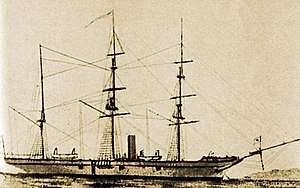
Emperor Kōmei agreed with such sentiments and, breaking with centuries of imperial tradition, began to take an active role in matters of state: as opportunities arose, he vehemently protested against the treaties and attempted to interfere in the shogunal succession. His efforts culminated in March 1863 with his "order to expel barbarians". Although the shogunate had no intention of enforcing it, the order nevertheless inspired attacks against the shogunate itself and against foreigners in Japan: the most famous incident was that of the English trader Charles Lennox Richardson, for whose death the Tokugawa government had to pay an indemnity of one hundred thousand British pounds.[10] Other attacks included the shelling of foreign shipping in the port of Shimonoseki.[11]
During 1864, these actions were successfully countered by armed retaliations by foreign powers, such as the British bombardment of Kagoshima and the multinational Shimonoseki campaign. At the same time, the forces of Chōshū Domain, together with rōnin, raised the Hamaguri rebellion trying to seize the city of Kyoto, where the Emperor's court was held, but were repelled by shogunate forces under the future shōgun Tokugawa Yoshinobu. The shogunate further ordered a punitive expedition against Chōshū, the First Chōshū expedition, and obtained Chōshū's submission without actual fighting. At this point the initial resistance among the leadership in Chōshū and the Imperial Court subsided, but over the next year the Tokugawa proved unable to reassert full control over the country as most daimyōs began to ignore orders and questions from the Tokugawa seat of power in Edo.[12]
Foreign military assistance
Despite the bombardment of Kagoshima, the Satsuma Domain had become closer to the British and was pursuing the modernization of its army and navy with their support.[13] The Scottish merchant Thomas Blake Glover sold quantities of warships and guns to the southern domains.[14] American and British military experts, usually former officers, may have been directly involved in this military effort.[15] The British ambassador Harry Smith Parkes supported the anti-shogunate forces in a drive to establish a legitimate, unified Imperial rule in Japan, and to counter French influence with the shogunate. During that period, southern Japanese leaders such as Saigō Takamori of Satsuma, or Itō Hirobumi and Inoue Kaoru of Chōshū cultivated personal connections with British diplomats, notably Ernest Mason Satow.[16]
In preparation for future conflict, the shogunate also modernized its forces. In line with Parkes's strategy, the British, previously the shogunate's primary foreign partner, proved reluctant to provide assistance.[17] The Tokugawa thus came to rely mainly on French expertise, comforted by the military prestige of Napoleon III at that time, acquired through his successes in the Crimean War and the Second Italian War of Independence.[18]
The shogunate took major steps towards the construction of a modern and powerful military: a navy with a core of eight steam warships had been built over several years and was already the strongest in Asia.[19] In 1865, Japan's first modern naval arsenal was built in Yokosuka by the French engineer Léonce Verny. In January 1867, a French military mission arrived to reorganize the shogunate army and create the Denshūtai elite force, and an order was placed with the US to buy the French-built ironclad warship CSS Stonewall,[20] which had been built for the Confederate States Navy during the American Civil War. Due to the Western powers' declared neutrality, the US refused to release the ship, but once neutrality was lifted, the imperial faction obtained the vessel and employed it in engagements in Hakodate under the name Kōtetsu ("Ironclad").[21]
Coups d'état
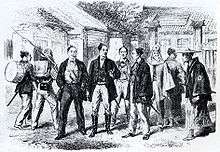
Following a coup d'état within Chōshū which returned to power the extremist factions opposed to the shogunate, the shogunate announced its intention to lead a Second Chōshū expedition to punish the renegade domain. This, in turn, prompted Chōshū to form a secret alliance with Satsuma. In the summer of 1866, the shogunate was defeated by Chōshū, leading to a considerable loss of authority. In late 1866, however, first shōgun Tokugawa Iemochi and then Emperor Kōmei died, succeeded by Tokugawa Yoshinobu and Emperor Meiji respectively. These events, in the words of historian Marius Jansen, "made a truce inevitable".[22]
On November 9, 1867, a secret order was created by Satsuma and Chōshū in the name of Emperor Meiji commanding the "slaughtering of the traitorous subject Yoshinobu".[23] Just prior to this however, and following a proposal from the daimyō of the Tosa Domain, Yoshinobu resigned his post and authority to the emperor, agreeing to "be the instrument for carrying out" imperial orders.[24] This ended the Tokugawa shogunate.[25]
While Yoshinobu's resignation had created a nominal void at the highest level of government, his apparatus of state continued to exist. Moreover, the shogunate government, the Tokugawa family in particular, remained a prominent force in the evolving political order and retained many executive powers,[26] a prospect hard-liners from Satsuma and Chōshū found intolerable.[27] Events came to a head on January 3, 1868, when these elements seized the imperial palace in Kyoto, and the following day had the fifteen-year-old Emperor Meiji declare his own restoration to full power. Although the majority of the imperial consultative assembly representing all the domains was happy with the formal declaration of direct rule by the imperial court and tended to support a continued collaboration with the Tokugawa (under the concept of "just government" (公議政体, kōgiseitai)), Saigō Takamori threatened the assembly into abolishing the title "shōgun" and ordering the confiscation of Yoshinobu's lands.[28]
Although he initially agreed to these demands, on January 17, 1868, Yoshinobu declared that he would not be bound by the Restoration proclamation and called for its repeal.[29] On January 24, he decided to prepare an attack on Kyoto, which was occupied by Satsuma and Chōshū forces. This decision was prompted by his learning of a series of arsons in Edo, starting with the burning of the outer works of Edo Castle, the main Tokugawa residence. This was blamed on Satsuma rōnin, who on that day attacked a government office. The next day shogunate forces responded by attacking the Edo residence of the daimyō of Satsuma, where many opponents of the shogunate, under Takamori's direction, had been hiding and creating trouble. The residence was burned down, and many opponents killed or later executed.[30]
Weapons and uniforms
The forces of Chōshū and Satsuma were fully modernized with Armstrong Guns, Minié rifles and one Gatling gun.[31][32] The shogunate forces had been slightly lagging in terms of equipment, although the French military mission had recently trained a core elite force.[31] The shōgun also relied on troops supplied by allied domains, which were not necessarily as advanced in terms of military equipment and methods, composing an army that had both modern and outdated elements.[31][33]
Individual guns
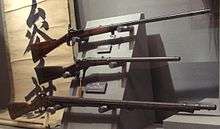
Numerous types of more or less modern smoothbore muskets and rifles were imported, from countries as varied as France, Germany, the Netherlands, Britain, and the United States, and coexisted with traditional types such as the tanegashima matchlock.[32] Most shogunate troops used smoothbore muskets, about 200,000 of which had been imported into Japan over the years since around 1600.[32]
The first modern firearms were initially imported about 1840 from the Netherlands by the pro-Western reformist Takashima Shūhan.[32][34] The daimyō of Nagaoka however, an ally of the shōgun, possessed two Gatling guns and several thousand modern rifles.[35][36] The shogunate is known to have placed an order for 30,000 modern Dreyse needle guns in 1866. Napoleon III provided Yoshinobu with 2,000 state-of-the-art Chassepot rifles, which he used to equip his personal guard. Antiquated tanegashima matchlocks are also known to have been used by the shogunate, however.[37]
Imperial troops mainly used Minié rifles, which were much more accurate, lethal, and had a much longer range than the imported smoothbore muskets, although, being also muzzle-loading, they were similarly limited to two shots per minute. Improved breech-loading mechanisms, such as the Snider, developing a rate of about ten shots a minute, are known to have been used by Chōshū troops against the shogunate's Shōgitai regiment at the Battle of Ueno in July 1868. In the second half of the conflict, in the northeast theater, Tosa troops are known to have used American-made Spencer repeating rifles.[37] American-made handguns were also popular, such as the 1863 Smith & Wesson Army No 2, which was imported to Japan by Glover and used by Satsuma forces.[37]
Artillery
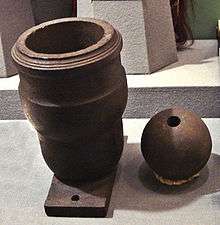
For artillery, wooden cannons, only able to fire 3 or 4 shots before bursting, coexisted with state-of-the-art Armstrong guns using explosive shells. Armstrong guns were efficiently used by Satsuma and Saga troops throughout the war. The Shogunate as well as the Imperial side also used native Japanese cannons, with Japan making cannons domestically as far back as 1575.[38]
Warships
In the area of warships also, some of the most recent ironclads such as the Kōtetsu coexisted with older types of steamboats and even traditional sailboats.[39][21] The shogunate initially had the edge in warships, and it had the vision to buy the Kōtetsu. The ship was blocked from delivery by foreign powers on grounds of neutrality once the conflict had started, and was ultimately delivered to the Imperial faction shortly after the Battle of Toba–Fushimi.[21]
Uniforms
Uniforms were Western-style for modernized troops (usually dark, with variations in the shape of the helmet: tall conical for Satsuma, flat conical for Chōshū, rounded for the shogunate).[40] Officers of the shogunate often wore French and British uniforms. Traditional troops however retained their samurai clothes.[40] Some of the Imperial troops wore peculiar headgear, involving the use of long, colored, "bear" hair. The "red bear" (赤熊, shaguma) wigs indicated officers from Tosa, the "white bear" (白熊, haguma) wigs officers from Chōshū, and the "black bear" (黒熊, koguma) wigs officers from Satsuma.[41]
Opening conflicts

On January 27, 1868, shogunate forces attacked the forces of Chōshū and Satsuma, clashing near Toba and Fushimi, at the southern entrance to Kyoto in the Battle of Toba–Fushimi. Some parts of the 15,000-strong shogunate forces had been trained by French military advisers. These forces were known as the Shinsengumi.[42][37] The forces of Chōshū and Satsuma were outnumbered 3:1 but fully modernized with Armstrong howitzers, Minié rifles and a few Gatling guns.[37]
After an inconclusive start,[43] on the second day, an Imperial banner was presented to the defending troops, and a relative of the Emperor, Ninnajinomiya Yoshiaki, was named nominal commander in chief, making the forces officially an imperial army (官軍, kangun).[44] Moreover, convinced by courtiers, several local daimyōs, up to this point faithful to the shōgun, started to defect to the side of the Imperial Court. These included the daimyōs of Yodo and Tsu in February, tilting the military balance in favor of the Imperial side.[45]
After the defections, Yoshinobu, apparently distressed by the imperial approval given to the actions of Satsuma and Chōshū, fled Osaka aboard the Japanese battleship Kaiyō Maru, withdrawing to Edo. Demoralized by his flight and by the betrayal by Yodo and Tsu, shogunate forces retreated, resulting in an Imperial victory, although it is often considered the shogunate forces should have won the encounter.[46] Osaka Castle was soon invested on March 1 (February 8 in the Tenpō calendar), putting an end to the battle.[47]
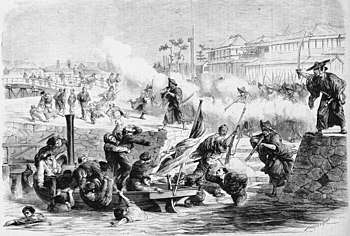
The day after the battle of Toba–Fushimi commenced, the naval Battle of Awa took place between the shogunate and elements of the Satsuma navy in Awa Bay near Osaka. This was Japan's second engagement between two modern navies.[48] The battle, although small in scale, ended with a victory of for the shogunate.[49]
On the diplomatic front, the ministers of foreign nations, gathered in the open harbor of Hyōgo (present day Kobe) in early February, issued a declaration according to which the shogunate was still considered the only rightful government in Japan, giving hope to Tokugawa Yoshinobu that foreign nations (especially France) might consider an intervention in his favor. A few days later however an Imperial delegation visited the ministers declaring that the shogunate was abolished, that harbors would be open in accordance with International treaties, and that foreigners would be protected. The ministers finally decided to recognize the new government.[50]
The rise of anti-foreign sentiment nonetheless led to several attacks on foreigners in the following months. Eleven French sailors from the corvette Dupleix were killed by samurai of Tosa in the Sakai incident on March 8, 1868. Fifteen days later, Sir Harry Parkes, the British ambassador, was attacked by a group of samurai in a street of Kyoto.[51]
Surrender of Edo

Beginning in February, with the help of the French ambassador Léon Roches, a plan was formulated to stop the Imperial Court's advance at Odawara, the last strategic entry point to Edo, but Yoshinobu decided against the plan. Shocked, Léon Roches resigned from his position. In early March, under the influence of the British minister Harry Parkes, foreign nations signed a strict neutrality agreement, according to which they could not intervene or provide military supplies to either side until the resolution of the conflict.[52]
Saigō Takamori led the victorious imperial forces north and east through Japan, winning the Battle of Kōshū-Katsunuma. He eventually surrounded Edo in May 1868, leading to its unconditional defeat after Katsu Kaishū, the shōgun's Army Minister, negotiated the surrender.[53] Some groups continued to resist after this surrender but were defeated in the Battle of Ueno on July 4, 1868.[54][55]
Meanwhile, the leader of the shōgun's navy, Enomoto Takeaki, refused to surrender all his ships. He remitted just four ships, among them the Fujiyama, but he then escaped north with the remnants of the shōgun's navy (eight steam warships: Kaiten, Banryū, Chiyodagata, Chōgei, Kaiyō Maru, Kanrin Maru, Mikaho and Shinsoku), and 2,000 personnel, in the hope of staging a counter-attack together with the northern daimyōs. He was accompanied by a handful of French military advisers, notably Jules Brunet, who had formally resigned from the French Army to accompany the rebels.[56]
Resistance of the Northern Coalition
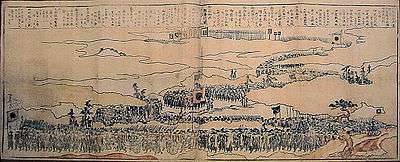
After Yoshinobu's surrender,[57] most of Japan accepted the emperor's rule, but a core of domains in the North, supporting the Aizu clan, continued the resistance.[58] In May, several northern daimyōs formed an Alliance to fight Imperial troops, the coalition of northern domains composed primarily of forces from the domains of Sendai, Yonezawa, Aizu, Shōnai and Nagaoka, with a total of 50,000 troops.[59]
In May 1868, the daimyō of Nagaoka inflicted high losses on the Imperial troops in the Battle of Hokuetsu, but his castle ultimately fell on May 19. Imperial troops continued to progress north, defeating the Shinsengumi at the Battle of Bonari Pass, which opened the way for their attack on the castle of Aizuwakamatsu in the Battle of Aizu in October 1868, thus making the position in Sendai untenable.[60]
Enomoto's fleet reached Sendai harbor on August 26. Although the Northern Coalition was numerous, it was poorly equipped, and relied on traditional fighting methods. Modern armament was scarce, and last-minute efforts were made to build cannons made of wood and reinforced with roping, firing stone projectiles. Such cannons, installed on defensive structures, could only fire four or five projectiles before bursting.[61] On the other hand, the daimyō of Nagaoka managed to procure two of the three Gatling guns in Japan and 2,000 modern French rifles from the German weapons dealer Henry Schnell.[35]
The coalition crumbled, and on October 12, 1868, the fleet left Sendai for Hokkaidō, after having acquired two more ships (Oe and Hōō, previously borrowed by Sendai from the shogunate), and about 1,000 more troops: remaining shogunate troops under Ōtori Keisuke, Shinsengumi troops under Hijikata Toshizō, the guerilla corps (yugekitai) under Hitomi Katsutarō, as well as several more French advisers (Fortant, Garde, Marlin, Bouffier).[56]
On October 26, Edo was renamed Tokyo, and the Meiji period officially started. Aizu was besieged starting that month, leading to the mass suicide of the Byakkotai (White Tiger Corps) young warriors.[62] After a protracted month-long battle, Aizu finally admitted defeat on November 6.[63]
Hokkaidō campaign
Creation of the Ezo Republic
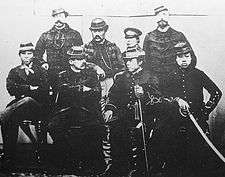
Following defeat on Honshū, Enomoto Takeaki fled to Hokkaidō with the remnants of the navy and his handful of French advisers. Together they organized a government, with the objective of establishing an independent island nation dedicated to the development of Hokkaidō. They formally established the Republic of Ezo on the American model, Japan's only ever republic, and Enomoto was elected as president, with a large majority. The republic tried to reach out to foreign legations present in Hakodate, such as the Americans, French, and Russians, but was not able to garner any international recognition or support. Enomoto offered to confer the territory to the Tokugawa shōgun under Imperial rule, but his proposal was declined by the Imperial Governing Council.[64]
During the winter, they fortified their defenses around the southern peninsula of Hakodate, with the new fortress of Goryōkaku at the center. The troops were organized under a Franco-Japanese command, the commander-in-chief Ōtori Keisuke being seconded by the French captain Jules Brunet, and divided between four brigades. Each of these was commanded by a French non-commissioned officer (Fortant, Marlin, Cazeneuve, Bouffier), and were themselves divided into eight half-brigades, each under Japanese command.[65]
Final losses and surrender

The Imperial Navy reached the harbor of Miyako on March 20, but anticipating the arrival of the Imperial ships, the Ezo rebels organized a daring plan to seize the Kōtetsu. Led by Shinsengumi commander Hijikata Toshizō, three warships were dispatched for a surprise attack, in what is known as the Battle of Miyako Bay. The battle ended in failure for the Tokugawa side, owing to bad weather, engine trouble and the decisive use of a Gatling gun by Imperial troops against samurai boarding parties.[66][67]
Imperial forces soon consolidated their hold on mainland Japan, and, in April 1869, dispatched a fleet and an infantry force of 7,000 to Ezo, starting the Battle of Hakodate. The Imperial forces progressed swiftly and won the naval engagement at Hakodate Bay, Japan's first large-scale naval battle between modern navies, and the fortress of Goryōkaku was surrounded. Seeing the situation had become desperate, the French advisers escaped to a French ship stationed in Hakodate Bay—Coëtlogon, under the command of Dupetit Thouars—from where they were shipped back to Yokohama and then France. The Japanese requested that the French advisers be given judgement in France; however, due to popular support in France for their actions, the former French advisers were not punished for their actions.[67]
Invited to surrender, Enomoto at first refused, and sent the Naval Codes he had brought back from Holland to the general of the Imperial troops, Kuroda Kiyotaka, to prevent their loss. Ōtori Keisuke convinced him to surrender, telling him that deciding to live through defeat is the truly courageous way: "If it's dying you want you can do it anytime."[68] Enomoto surrendered on June 27, 1869, accepting Emperor Meiji's rule, and the Ezo Republic ceased to exist.
Aftermath
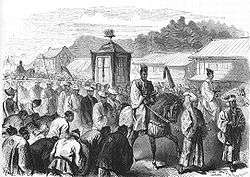
Of the approximately 120,000 men mobilized over the course of the conflict, about 8,200 were killed and more than 5,000 were wounded.[4] Following victory, the new government proceeded with unifying the country under a single, legitimate and powerful rule by the Imperial Court. The emperor's residence was effectively transferred from Kyoto to Edo at the end of 1868, and the city renamed to Tokyo. The military and political power of the domains was progressively eliminated, and the domains themselves were transformed in 1871 into prefectures, whose governors were appointed by the emperor.[69][70]
A major reform was the effective expropriation and abolition of the samurai class, allowing many samurai to change into administrative or entrepreneurial positions, but forcing many others into poverty.[71] The southern domains of Satsuma, Chōshū and Tosa, having played a decisive role in the victory, occupied most of the key posts in government for several decades following the conflict, a situation sometimes called the "Meiji oligarchy" and formalized with the institution of the genrō.[72] In 1869, the Yasukuni Shrine in Tokyo was built in honor of the victims of the Boshin War.[73]
Some leading partisans of the former shōgun were imprisoned, but narrowly escaped execution. This clemency derives from the insistence of Saigō Takamori and Iwakura Tomomi, although much weight was placed on the advice of Parkes, the British envoy. He had urged Saigō, in the words of Ernest Satow, "that severity towards Keiki [Yoshinobu] or his supporters, especially in the way of personal punishment, would injure the reputation of the new government in the opinion of European Powers".[74] After two or three years of imprisonment, most of them were called to serve the new government, and several pursued brilliant careers. Enomoto Takeaki, for instance, would later serve as an envoy to Russia and China and as the education minister.[75]
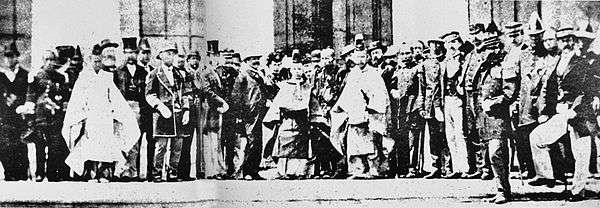
The Imperial side did not pursue its objective to expel foreign interests from Japan, but instead shifted to a more progressive policy aiming at the continued modernization of the country and the renegotiation of unequal treaties with foreign powers, later under the "rich country, strong army" (富国強兵, fukoku kyōhei) motto.[76]
The shift in stance towards the foreigners came during the early days of the civil war: on April 8, 1868, new signboards were erected in Kyoto (and later throughout the country) that specifically repudiated violence against foreigners.[77] During the course of the conflict, Emperor Meiji personally received European envoys, first in Kyoto, then later in Osaka and Tokyo.[78] Also unprecedented was Emperor Meiji's reception of Alfred, Duke of Edinburgh, in Tokyo, "as his equal in point of blood".[79]
Although the early Meiji era witnessed a warming of relations between the Imperial Court and foreign powers, relations with France temporarily soured due to the initial support by France for the shōgun. Soon however a second military mission was invited to Japan in 1874, and a third one in 1884. A high level of interaction resumed around 1886, when France helped build the Imperial Japanese Navy's first large-scale modern fleet, under the direction of naval engineer Louis-Émile Bertin.[80] The modernization of the country had started during the last years of the shogunate, and the Meiji government ultimately adopted the same policy.
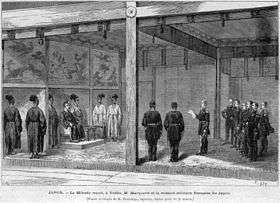
Upon his coronation, Meiji issued his Charter Oath, calling for deliberative assemblies, promising increased opportunities for the common people, abolishing the "evil customs of the past", and seeking knowledge throughout the world "to strengthen the foundations of imperial rule".[81] The reforms culminated in the 1889 issuance of the Meiji Constitution. However, despite the support given to the Imperial Court by samurai, many of the early Meiji reforms were seen as detrimental to their interests. The creation of a conscript army made of commoners, as well as the loss of hereditary prestige and stipends, antagonized many former samurai.[82] Tensions ran particularly high in the south, leading to the 1874 Saga Rebellion, and a rebellion in Chōshū in 1876. Former samurai in Satsuma, led by Saigō Takamori, who had left government over foreign policy differences, started the Satsuma Rebellion in 1877. Fighting for the maintenance of the samurai class and a more virtuous government, their slogan was "new government, high morality" (新政厚徳, shinsei kōtoku). It ended with a heroic but total defeat at the Battle of Shiroyama.[83]
Later depictions
In modern summaries, the Meiji Restoration is often described as a "bloodless revolution" leading to the sudden modernization of Japan. The facts of the Boshin War, however, clearly show that the conflict was quite violent: about 120,000 troops were mobilized altogether with roughly 3,500 known casualties during open hostilities but much more during terrorist attacks.[86] Later Japanese depictions of the war tended to be highly romanticized, showing the shogunal side fighting with traditional methods, against an already modernized Imperial side. Although traditional weapons and techniques were used, both sides employed some of the most modern armaments and fighting techniques of the period, including the ironclad warship, Gatling guns, and fighting techniques learned from Western military advisers.
Such Japanese depictions include numerous dramatizations, spanning many genres. Notably, Jirō Asada wrote a four-volume novel of the account, Mibu Gishi-den.[87] A film adaptation of Asada's work, directed by Yōjirō Takita, is known as When the Last Sword Is Drawn.[87] A ten-hour 2002 television jidaigeki based on the same novel starred Ken Watanabe.[88]
Western interpretations include the 2003 American film The Last Samurai directed by Edward Zwick, which combines into a single narrative historical situations belonging both to the Boshin War, the 1877 Satsuma Rebellion, and other similar uprisings of ex-samurai during the early Meiji period.[89] The elements of the movie pertaining to the early modernization of Japan's military forces as well as the direct involvement of foreign (mostly French) forces relate to the Boshin War and the few years leading to it.[89] However, the suicidal stand of traditionalist samurai forces led by Saigō Takamori against the modernized Imperial army relate to the much later Satsuma Rebellion.[90]
The main campaign in the 2012 expansion to Creative Assembly's game Total War: Shogun 2: Fall of the Samurai depicts the Boshin War.[91] Players can choose from various historical clans, such as the Imperial Satsuma or the shogunate Aizu.[91]
Notes
- Banno, p. 39.
- Banno, p. 48.
- 15.000 soldiers during the Toba-Fushimi campaign. Banno, p. 42.
- Huffman, James L., Modern Japan: An Encyclopedia of History, Culture, and Nationalism, Garland Reference Library of the Humanities; Routledge (1997) p. 22. ISBN 978-0815325253
- 戊辰(ぼしん) の意味 [Boshin (Boshin) definition] (in Japanese). NTT Resonant, Inc. Archived from the original on 1 May 2020. Retrieved 1 May 2020.
- Nussbaum, p. 505.
- Nussbaum, p. 624.
- Thanks to the interaction with the Dutch, the study of Western science continued during this period under the name of rangaku, allowing Japan to study and follow most of the steps of the scientific and industrial revolution. Jansen (pp. 210–215) discusses the vibrancy of Edo period rangaku, and notes (p. 346) the competition in the early Meiji period for foreign experts and rangaku scholars. See also: "The technology of Edo" (見て楽しむ江戸のテクノロジー), 2006, ISBN 4-410-13886-3 (Japanese) and "The intellectual world of Edo" (江戸の思想空間) Timon Screech, 1998, ISBN 4-7917-5690-8 (Japanese).
- Hagiwara, p. 34.
- Jansen, pp. 314–315.
- Hagiwara, p. 35.
- Jansen, pp. 303–305.
- Hagiwara, pp. 34–35.
- As early as 1865, Thomas Blake Glover sold 7,500 Minié rifles to the Chōshū clan, allowing it to become totally modernized. Nakaoka Shintaro a few months later remarked that "in every way the forces of the han have been renewed; only companies of rifle and cannon exist, and the rifles are Minies, the cannon breech loaders using shells." Brown.
- This is a claim made by Jules Brunet in a letter to Napoleon III: "I must signal to the Emperor the presence of numerous American and British officers, retired or on leave, in this party [of the southern daimyōs] which is hostile to French interests. The presence of Western leaders among our enemies may jeopardize my success from a political standpoint, but nobody can stop me from reporting from this campaign information Your Majesty will without a doubt find interesting." Original quotation (French): "Je dois signaler à l'Empereur la présence de nombreux officers américains et anglais, hors cadre et en congé, dans ce parti hostile aux intérêts français. La présence de ces chefs occidentaux chez nos adversaires peut m'empêcher peut-être de réussir au point de vue politique, mais nul ne pourra m'empêcher de rapporter de cette campagne des renseignements que Votre Majesté trouvera sans doute intéressants." Polak, p. 81. As an example, the English Lieutenant Horse is known to have been a gunnery instructor for the Saga domain during the Bakumatsu period. "Togo Heiachiro", p. 17.
- These encounters are described in Satow's 1869 A Diplomat in Japan, where he famously describes Saigō as a man with "an eye that sparkled like a big black diamond".
- For example, An 1864 request to Sir Rutherford Alcock to supply British military experts from the 1,500 men stationed at Yokohama went unanswered, and when Takenaka Shibata visited the United Kingdom and France, in September 1865, requesting assistance, only the latter was forthcoming.
- Following the deal with France, the French ambassador in Japan Leon Roches, trying not to alienate the United Kingdom, arranged for the shōgun to ask for a British navy mission which arrived sometime after the French military mission of 1867. Polak, pp. 53–55.
- A detailed presentation of the shogunate navy is available at this site Archived September 23, 2006, at the Wayback Machine (Japanese)
- Naval Historical Center Archived February 14, 2008, at the Wayback Machine
- Keene, pp. 165–166.
- Jansen, p. 307.
- There is debate as to the authenticity of the order, due to its violent language and the fact that, despite using the imperial pronoun (朕, chin), it did not bear Meiji's signature. Keene, pp. 115–116.
- Satow, p. 282.
- Keene, p. 116. See also Jansen, pp. 310–311.
- Keene, pp. 120–121, and Satow, p. 283. Moreover, Satow (p. 285) speculates that Yoshinobu had agreed to an assembly of daimyōs on the hope that such a body would restore him.
- Satow, p. 286.
- During a recess, Saigō, who had his troops outside, "remarked that it would take only one short sword to settle the discussion" (Keene, p. 122). Original quotation (in Japanese): "短刀一本あればかたづくことだ" in Hagiwara, p. 42. The specific word used for "dagger" was "tantō".
- Keene, p. 124.
- Keene, p. 125.
- Esposito, pp. 23–34.
- Esposito, pp. 40–41.
- Ravina (2005), pp.149-160
- Jansen, p. 288.
- Vaporis, p. 35.
- Esposito, p. 10.
- Ryozen Museum of History exhibit
- Perrin, p. 19.
- 幕府海軍 [Bakufu Navy] (in Japanese). TRPG『維新の嵐』. Archived from the original on 11 May 2001. Retrieved 1 May 2020.
- Esposito, pp. 17–23.
- Gonick, p. 25.
- Vaporis, p. 33.
- Saigō, while excited at the beginning of combat, had planned for the evacuation of the emperor from Kyoto if the situation demanded it. Keene, pp. 125–126.
- The red and white pennant had been conceived and designed by Okubo Toshimichi and Iwakura Tomomi, among others. It was in effect a forgery, as was the imperial order to deploy it among the defending troops. Prince Yoshiaki, was also given a special sword and appointed "great general, conqueror of the east", and the shogunal forces opposing Yoshiaki were branded "enemies of the court". Keene, pp. 126–127.
- A detailed description of the battle is available in Hagiwara, p. 42.
- "Militarily, the Tokugawa were vastly superior. They had between three to five times more soldiers and held Osaka Castle as a base, they could count on the forces from Edo modernized by the French, and they had the most powerful fleet of East Asia at hand in Osaka Bay. In a regular fight, the Imperial side had to lose. Saigō Takamori too, anticipating defeat had planned to move the Emperor to the Chūgoku mountains and was preparing for guerilla warfare." Hagiwara, p. 43. Translation from the Japanese original.
- Hagiwara, pp. 43–45.
- "Togo Heihachiro in images, illustrated Meiji Navy" (図説東郷平八郎、目で見る明治の海軍). The first was the Battle of Shimonoseki Straits (1863).
- Tucker, p. 274.
- Polak, p. 75.
- "Sommaire". Le Monde illustré (in French). No. 583. 13 June 1868. p. 1. Retrieved 11 May 2020.
- Polak, p. 77.
- Hagiwara, p. 46
- Ravina, Mark (2005). The Last Samurai: The Life and Battles of Saigō Takamori. Wiley. ISBN 0-471-70537-3.
- Perez, p. 32.
- Polak, p. 81.
- Tokugawa Yoshinobu was placed under house arrest, and stripped of all titles, land and power. He was later released, when he demonstrated no further interest and ambition in national affairs. He retired to Shizuoka, the place to which his ancestor Tokugawa Ieyasu, had also retired.
- Bolitho, p. 246; Black, p. 214.
- Polak, pp. 79–91. Apart from those core domains, most of the northern domains were part of the alliance.
- Turnbull, pp. 153–158.
- A detailed presentation of artifacts from that phase of the war is visible at the Sendai City Museum, in Sendai, Japan.
- An account of the resistance of the Byakkotai can be accessed here Archived February 6, 2007, at the Wayback Machine (English)
- Turnbull, p. 11.
- In a letter of Enomoto to the Imperial Governing Council: "We pray that this portion of the Empire may be conferred upon our late lord, Tokugawa Kamenosuke; and in that case, we shall repay your beneficence by our faithful guardianship of the northern gate." Black, pp. 240–241.
- Polak, pp. 85–89.
- Collache was on board one of the ships that participated to the attack. He had to wreck his ship and flee overland, until he surrendered with his colleagues and was transferred to a prison in Tokyo. He ultimately returned to France safely to tell his story. The encounter is detailed in Collache, "Une aventure au Japon".
- Collache, 1874.
- Polak et al.
- Gordon, pp. 64–65.
- Many daimyōs were appointed as the first governors, and subsequently given peerages and large pensions. Over the following years, the three hundred domains were reduced to fifty prefectures. Jansen, pp. 348–349.
- Most legal distinctions between samurai and ordinary subjects were soon abolished, and the traditional rice stipends paid to samurai were first converted into cash stipends, and these were later converted at a steep discount to government bonds. Gordon pp. 64–65.
- For example Saigō Takamori, Okubo Toshimichi, and Tōgō Heihachirō all came from Satsuma. Discussed in Togo Heihachiro in images: Illustrated Meiji Navy.
- BBC News article, Tuesday, 15 August 2006
- Quoted in Keene, p. 143.
- Discussed in Polak et al. See also, Keene.
- Keene, pp. 206–209.
- Keene, p. 142.
- Keene, pp. 143–144, 165.
- Parkes, quoted in Keene, pp. 183–187. Emphasis in the original.
- Discussed in Evans and Peattie.
- Jansen, pp. 338. See Jansen, pp. 337–343 for political developments during and relating to the course of the war. See Keene, pp. 138–142, for discussion of the Charter Oath and signboard decrees.
- Jansen, pp. 367–368.
- Hagiwara, pp. 94–120. Saigō himself professed continued loyalty to Meiji and wore his Imperial Army uniform throughout the conflict. He committed suicide before the final charge of the rebellion, and was posthumously pardoned by the emperor in subsequent years. Jansen, pp. 369–370.
- The shogunate leaders are labeled from left to right, Enomoto (Kinjirō) Takeaki, Ōtori Keisuke, Matsudaira Tarō. The samurai in yellow garment is Hijikata Toshizō.
- The "Red bear" (赤熊, Shaguma) wigs indicate soldiers from Tosa, the "White bear" (白熊, Haguma) wigs for Chōshū, and the "Black bear" (黒熊, Koguma) wigs for Satsuma.
- Hagiwara, p. 50.
- Galloway, Patrick (2012). Berra, John (ed.). Directory of World Cinema: Japan 2. Bristol, England: Intellect Books. pp. 162–163. ISBN 978-1841505510.
- 時代劇☆壬生義士伝 [Jidaigeki: Mibu Gishiden] (in Japanese). TV Tokyo. Archived from the original on 25 March 2020. Retrieved 25 March 2020.
- Mclaughlin, William (11 November 2016). "The Last Samurai: The True History Behind The Film". War History Online. Archived from the original on 25 March 2020. Retrieved 25 March 2020.
- Ravina, Mark J. (August 2010). "The Apocryphal Suicide of Saigō Takamori: Samurai, "Seppuku", and the Politics of Legend". The Journal of Asian Studies. 69 (3): 691–721. doi:10.1017/S0021911810001518. JSTOR 40929189.
- Senior, Tom (16 March 2012). "Shogun 2: Fall of the Samurai review". PC Gamer. Archived from the original on 25 March 2020. Retrieved 25 March 2020.
References
- Banno, Junji (2014). Japan's Modern History, 1857–1937: A New Political Narrative. London/New York.
- Bolitho, Harold (1974). Treasures among Men: The Fudai Daimyo in Tokugawa Japan. New Haven: Yale University Press. ISBN 0-300-01655-7, 978-0-300-01655-0; OCLC 185685588
- Black, John R. (1881). Young Japan: Yokohama and Yedo, Vol. II. London: Trubner & Co.
- Brown, Sidney DeVere (1994). "Nagasaki in the Meiji Restoration: Choshu loyalists and British arms merchants". Retrieved 28 April 2007.
- Collache, Eugène (1874). "Une aventure au Japon". Le Tour du Monde. No. 77.
- Esposito, Gabriele (2020). Japanese Armies 1868–1877: The Boshin War and Satsuma Rebellion. Oxford, England: Osprey Publishing. ISBN 978-1-4728-3708-0.
- Evans, David; Mark Peattie (1997). Kaigun: Strategy, Tactics, and Technology in the Imperial Japanese Navy, 1887–1941. Annapolis, Maryland: Naval Institute Press. ISBN 0-87021-192-7.
- Gonick, Gloria (2002). Matsuri! Japanese Festival Arts. University of California Museum. ISBN 0930741919.
- Gordon, Andrew (2003). A Modern History of Japan. New York: Oxford. ISBN 0-19-511060-9.
- Hagiwara, Kōichi (2004). 図説 西郷隆盛と大久保利通 [Illustrated life of Saigō Takamori and Ōkubo Toshimichi] (in Japanese). Kawade Shobo Shinsha. ISBN 4-309-76041-4.
- Jansen, Marius B. (2002). The Making of Modern Japan. Harvard. ISBN 0-674-00334-9, 978-0-674-00334-7; OCLC 44090600
- Keene, Donald (2005). Emperor of Japan: Meiji and His World, 1852–1912. Columbia.ISBN 0-231-12340-X, 978-0-231-12340-2; OCLC 46731178
- Nussbaum, Louis-Frédéric (2005). Japan Encyclopedia. Belknap Press / Harvard University Press. ISBN 0674017536.
- Okada, Shin'ichi; Tanaka, Akira; Polak, Christian; Konno, Tetsuya; Tsunabuchi, Kenjō (1988). 函館の幕末・維新 [End of the Bakufu and Restoration in Hakodate] (in Japanese). ISBN 4-12-001699-4.
- Perez, Louis G., ed. (2013). Japan at War: An Encyclopedia. Santa Barbara, California: ABC-CLIO. ISBN 978-1-59884-741-3. LCCN 2012030062.
- Polak, Christian (2001). Soie et lumières: L'âge d'or des échanges franco-japonais (des origines aux années 1950) (in French and Japanese). Tokyo: Hachette / Fujin Gahōsha.
- Polak, Christian (2002). 絹と光: 知られざる日仏交流100年の歴史 (江戶時代-1950年代) [Silk and Light: 100-year history of unconscious French-Japanese cultural exchange (Edo Period – 1950)] (in Japanese). Tokyo: Hachette / Fujin Gahōsha. ISBN 4-573-06210-6. OCLC 50875162.
- Satow, Ernest (1968) [1921]. A Diplomat in Japan. Tokyo: Oxford.
- Togo, Heihachirō (1993). 図説東郷平八郎、目で見る明治の海軍 [Togo Heihachirō in Images: Illustrated Meiji Navy] (in Japanese). 東郷神社・東郷会.
- Tucker, Spencer C. (2017). The Roots and Consequences of Civil Wars and Revolutions: Conflicts that Changed World History. Santa Barbara, California: ABC-CLIO. ISBN 978-1-4408-4294-8.
- Turnbull, Stephen (2008). The Samurai Swordsman: Master of War. Clarendon, Vermont: Tuttle Publishing. ISBN 978-4805309568.
- Vaporis, Constantine Nomikos (2019). Samurai: An Encyclopedia of Japan's Cultured Warriors. Santa Barbara, California: ABC-CLIO. ISBN 978-1440842702.
Further reading
- Jansen, Marius B. (1999). The Cambridge History of Japan Volume 5: The Nineteenth Century, Chapter 5, "The Meiji Restoration". Cambridge. ISBN 0-521-65728-8.
External links
| Wikimedia Commons has media related to Boshin War. |
- The Boshin War (in Japanese)
- The Battle of Ezo (in Japanese)
- National Archives of Japan: Boshinshoyo Kinki oyobi Gunki Shinzu, precise reproduction of Imperial Standard and the colors used by Government Army during Boshin War (1868)
